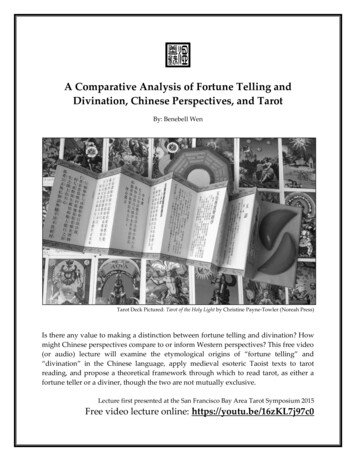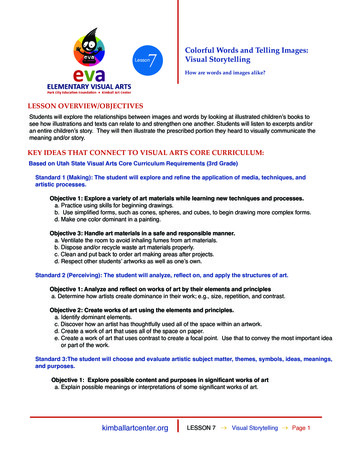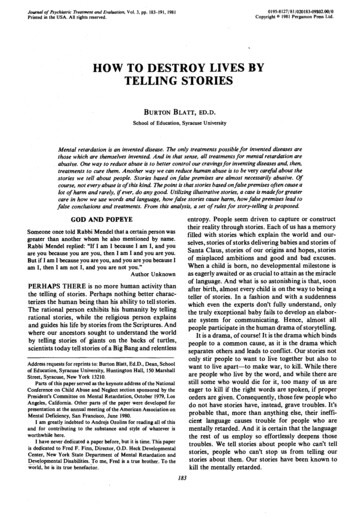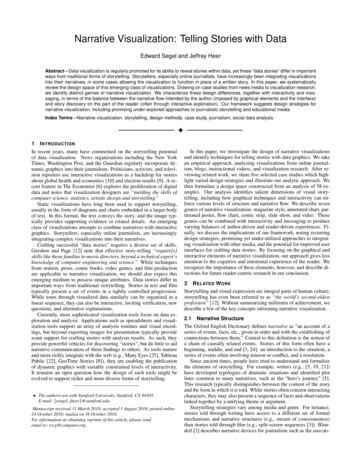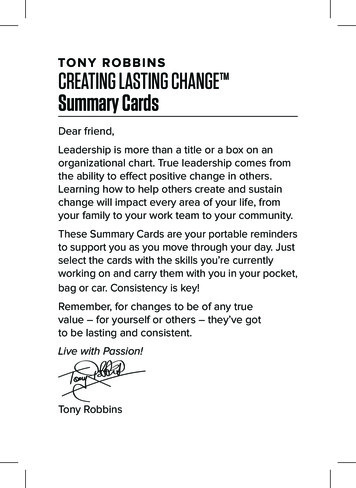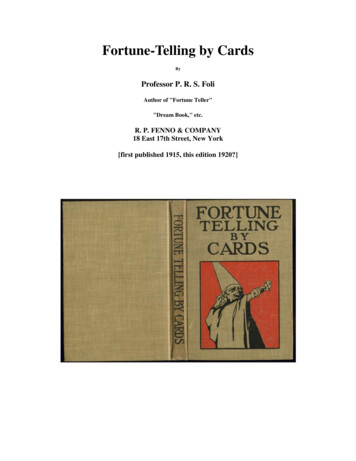
Transcription
Fortune-Telling by CardsByProfessor P. R. S. FoliAuthor of "Fortune Teller""Dream Book," etc.R. P. FENNO & COMPANY18 East 17th Street, New York[first published 1915, this edition 1920?]
ContentsCHAPTER IHOW WE GOT OUR PACK OF CARDSWhere do they come from?—The Romany Folk—Were they made in Europe?—Suits andsigns—The power of cards—Their charm and interest—Necessity for sympathy—Value ofCartomancyCHAPTER IIWHAT THE INDIVIDUAL CARDS SIGNIFYTwo systems—The English method—The foreign—Significations of the cards—Hearts—Diamonds—Clubs—Spades—A short table—Mystic meaningsCHAPTER IIITHE SELECTED PACK OF THIRTY-TWO CARDSReduced pack generally used—How to indicate reversed cards—Meaning of Hearts—Diamonds—Clubs—SpadesCHAPTER IVTHE SIGNIFICATION OF QUARTETTES, TRIPLETS, AND PAIRSCombinations of court cards—Combinations of plain cards—Various cards read together—General meaning of the several suits—Some lesser points to noticeCHAPTER VWHAT THE CARDS CAN TELL OF THE PAST, THE PRESENT, AND THE FUTUREA simple method—What the cards say—The Present—The FutureCHAPTER VIYOUR FORTUNE IN TWENTY-ONE CARDSA reduced pack—An example—The three packs—The surpriseCHAPTER VIICOMBINATION OF SEVENSA method with selected cards—General rules—How to proceed—Reading of the cards—Signification of cards—Some combinations—A typical example—Further inquiries—Theseven packs
CHAPTER VIIIANOTHER METHOD WITH THIRTY-TWO CARDSGeneral outline—Signification of cards—How to consult the cards—An illustration—ItsreadingCHAPTER IXA FRENCH METHODFrench system—The reading—An exampleCHAPTER XTHE GRAND STARThe number of cards may vary—The method—The reading in pairs—Diagram of the GrandStar—An exampleCHAPTER XIIMPORTANT QUESTIONS. FORTUNE-TELLING GAMESHow to answer them—Specimen questions—Cupid and Venus at workCHAPTER XIIHOW THEY TELL FORTUNES IN ITALYItalian method—An example—Notice the groups—How the pairs work out—The five packsCHAPTER XIIITHE MASTER METHOD. THE CHART AND ITS EXPLANATIONKnowledge is power—Four twos added to the usual pack—The thirty-six squares and theirsignificance—Tendencies of the suitsCHAPTER XIVTHE MASTER METHOD. SIGNIFICATIONS OF CARDS USEDCourt cards—Plain cards—An example of the Master MethodCHAPTER XVA COMBINATION OF NINESHow to work it—An example—The first reading—The second reading—The third readingCHAPTER XVIYOUR HEART'S DESIRE. SIX WAYS OF TRYING A WISH
The wish with fifteen cards—Another way—The wish with thirty-two cards—What the fouraces tell—The wish in seven packs—The wish card againCHAPTER XVIIRHYMING APTER XVIIITHE TAROTS: THEIR ORIGIN AND HISTORYDerivation of name—Remote origin—The great EtteillaCHAPTER XIXETTEILLA'S METHOD OF USING THE TAROTSThe major arcana—The minor arcana—General rules—The second deal—The third deal orgreat figure—The fourth deal
Introduction"THIS goddess Fortune frustrates, single-handed, the plans of a hundred learned men." In thissaying the Latin author has given us the key to all the restless striving to search out the Unknownand the Unknowable which marks our own age, just as it has marked previous periods in historywhich we are apt to look back upon as being but little removed from the dark ages.Of all the methods by which men and women seek to penetrate into the mysteries of Fate andFuturity, Cartomancy is one that can claim the distinction of having swayed the human mindfrom prehistoric times right down to this twentieth century of ours.It may be that this book will fall into the hands of those who agree with the words of L’Estrange:"There needs no more than impudence on the one side and a superstitious credulity on the otherto the setting up of a Fortune-teller." This attitude of cynical superiority is sometimes genuine,but in many cases if we could read what lies beneath the surface we should find that it is but acloak worn to conceal a lurking fear, an almost irritated condition of mind, born of a halfconfessed faith in the power at which it is so easy to scoff.There is a vein of superstition in every human heart, and many men who have played a great partin the world's history have not been ashamed to seek help from occultists, when the tangle of lifeseemed too involved for them to unravel with the ordinary means at their disposal.The pages of history are full of the penalties meted out by kings and rulers to those who wereaccused of working evil spells upon them. It needs but to mention the names of Wallenstein,Murat, King of Naples; Bernadotte, afterwards King of Sweden; and the merciless Robespierre,as types of a vast number over whom the fascinations of Astrology and Cartomancy, which areso closely allied, have cast their witching spell.Pope treats the cards as sentient entities:"The king, unseen,Lurked in her hand and mourned his captive queen."While in another passage he says:"Soon as she spreads her cards th’ aerial guardDescend and sit on each important card."In the following pages we have given information that will, we hope, afford interest andamusement to many. We have not dwelt on the gift of prophecy, or on the power of second sightclaimed by apostles of the occult. We would in no case obtrude the subject of Cartomancy uponthe notice of those whose susceptibilities would be wounded, or whose sense of right and wrongwould be outraged by the practice, and we have ventured to speak a word of warning to themorbidly minded.We give this method of Fortune-telling for what it is worth. It may be either a pastime seasonedwith a flavour of mystery, a study in the weird ways of coincidence, or a test of skill quickened
by intuition. We would have all our readers amused and interested, but none saddened orenslaved by it.
Fortune-Telling by CardsCHAPTER IHow we got our Pack of CardsWhere do they come from?—The Romany Folk—Were they made in Europe?—Suits and signs—The power ofcards—Their charm and interest—Necessity for sympathy—Value of Cartomancy.Where do They Come From?WHEN we take up an ordinary pack of cards to deal them out for a rubber, or to lay them downin the careful deliberation of Patience, or when we watch them being used as the inexplicableinstruments of a something that, with a feeling akin to superstitious dread, we prefer to callcoincidence, we do not often stop to think of the varied and eventful history represented by thosesmooth, highly-glazed playthings.The actual and authentic history of playing cards only goes back about five hundred years, andvarious theories have been mooted as to the source from which Europe obtained them. It is anestablished fact that in past ages many eastern peoples, notably those of India, China, andChaldea, possessed cards which differed materially both in use and design from those known inthe West at a later date. It is impossible to trace these prehistoric beginnings of card-lore, butthere seems little doubt that the Wise Men of eastern lands regarded their cards with none of thecontempt usually bestowed upon them in the West. They held them in high esteem as mediumsfor the partial revelation of the Unknowable, and included them as a part of their mystic lore.The Romany Folk.It is thought by many that we owe our cards to the gipsies, who are supposed to have been theoffspring of a low caste of Hindus, and who, driven from their own land, found their way, asfugitives, through Western Asia into Egypt, and from Northern Africa into Europe. It is certainthat all kinds of fortune-telling, whether by Cartomancy or whatever method, are inseparablyconnected with that curious, fascinating, highly gifted and elusive people. They excelled inmusic and ail mechanical pursuits; they could learn a language, or distinguish themselves inmetal work, with equal ease; but they had to live more or less on the defensive, as very childrenof Ishmael, and years of persecution only deepened their craftiness, sharpened their intuition, andrendered them more keen to assert their mysterious power over those who oppressed and yetinwardly feared them.These Romany folk have preserved intact the ancient lore of the East, while incredulous Europehas turned the sacred pages of divination from the book of fate into mere instruments ofamusement, and a vehicle for winning or losing money. The gipsy remains a past master in theart of Cartomancy, and though we may scoff, there are very few amongst us who do not feel asense of disquietude when brought face to face with an instance of her uncanny power. We canafford to laugh when the sun of our lives is shining brightly and all is well in mind and body, but
there come dark days in the lives of all, and then some are impelled to seek the aid of these weirdsons and daughters of an unknown land.By many, perhaps by the majority, this inexplicable gift has been vulgarised and debased to amere means of extorting money from the ignorant and the credulous; but by some it is still heldas a sacred faith—possibly no more superstitious than some forms of unenlightened or pervertedChristianityWere They Made in Europe?Another theory separates the cards of the West entirely from those of the East, and holds that thewestern were originally made in Europe. This is as it may be. A writer of the latter part of thefifteenth century says that cards were first known at Viterbo in 1379, and that they had beenintroduced by the Saracens, who, with the Arabs and Moors, have the credit of planting the seedsof Cartomancy in Spain. It is certain that at first cards were called by the name naibi; and theHebrew and Arabic words, Nabi, naba, nabaa, signify "to foretell." It is also widely believed thatthe idea of playing games with cards was an after-thought, and that their original purpose was forthe practice of divination.The earliest cards were the Tarots, of which we speak in another chapter, and it is supposed thatsome one had the bright idea of adding the numeral to the symbolical cards, so as to play gameswith them. This addition was made about the middle of the fourteenth century, and at thebeginning of the fifteenth century there was a pack in Venice composed of seventy-eight cards,twenty-two symbols and fifty-six numerals; with four coat (court) cards, king, queen, chevalier,and valet, and ten point or pip cards to each suit. The fifty-six numerals were subsequentlyreduced to the present number, fifty-two, by the rejection of one of the picture cards.The Spaniards discourteously abolished the queens, but the French, true to their reputation, keptthe dame and rejected the chevalier. The early German packs were the same as the French, butthe queens again were cast out in favour of a superior knave called the Obermann. Englandaccepted the Spanish or French pack as she found it.Suits and Signs.There have always been four suits, but there have been many changes in the signs used to markthem. The original quartette were:—Cups, supposed to be emblematical of Faith; Money,representing Charity; Swords, figuring Justice; and Clubs, typical of Fortitude. These signs arestill retained in the Tarots, and in Italian and Spanish cards. Old German packs have bells, hearts,leaves, and acorns; and during the fifteenth century the French adopted spades (pique), hearts,clubs (trèfle), and diamonds.There is some difficulty in tracing how we come by the word spade in this connection. It hasbeen thought to be a corruption of the Italian word spade, meaning swords. It is not known whythe French should have called this suit pique. Our suit of clubs is known by the French as trèfle,from their drawing the sign like the trefoil; and the Germans call it Eichel from its resemblanceto an acorn. Our name is supposed to show Italian influence, though where the connection
between the word bastoni and our sign is to be found, I am at a loss to say. The heart sign needsno explanation, and is found in French, German, and English packs. It corresponds to theSpanish and Italian sign of cups. By some curious evolution the signs of money and bells weresquared into the French carreaux, our diamonds.Many of the packs used in the fourteenth century were of the most artistic and costly nature, andin some cases the court cards were drawn so as to represent historic characters.The Power of Cards.Fierce controversies have ranged round these apparently simple pieces of glazed pasteboard.They have exercised such an irresistible fascination upon the minds of men and women of allgrades and ages that others have risen in wild revolt against this power, which had no attractionfor them, and which they longed to crush out of existence. There are still those amongst us whowill not have a card in the house, and who, even if they do not use it, acquiesce in the term "theDevil's books," which has been applied to the pack.With their use for gambling purposes we have nothing to do here. As the instruments ofCartomancy we give them our respectful consideration. We would urge those of a morbid andunhealthy turn of mind to beware of letting this practice take too strong a hold upon them. Noreasonable being need be ashamed of confessing a certain fear of the Unseen and theUnknowable; but, on the other hand, no sane person would take a pack of cards as the rule andguide of life, the final court of appeal in any matters of moment.Their Charm and Interest.There is much amusement to be derived from the study of Cartomancy, and it is not to be deniedthat there are certain persons who appear to have the power of making the meaning of the cardsvivid and convincing, while in the hands of others there seems neither rhyme nor reason in theirmanipulation of the most carefully shuffled pack. We may call things by what name we will, butstrange coincidences meet us at every turn, and now and then there seems but the thinnest veilbetween us and the Future, which is so sedulously hidden from us.There has been a great revival of interest in all matters relating to occultism in the immediatepast, and if we are to believe what we read and hear, educated men and women of to-day a
Descend and sit on each important card." In the following pages we have given information that will, we hope, afford interest and amusement to many. We have not dwelt on the gift of prophecy, or on the power of second sight claimed by apostles of the occult. We would in no case obtrude the subject of Cartomancy upon the notice of those whose susceptibilities would be wounded, or whose sense of .
